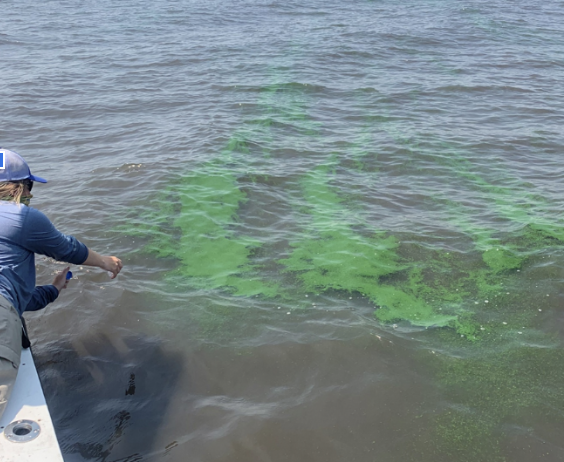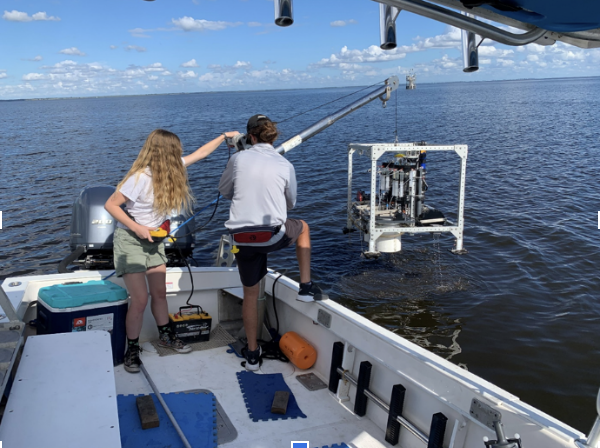Owen Silvera is a Florida Sea Grant Coastal and Ocean Fellow and a Master’s student in the Marine Science and Oceanography Department at Harbor Branch Oceanographic Institute (FAU). Mason Thackston is a Graduate Research Assistant at Harbor Branch Oceanographic Institute, FAU.
If you’ve ever lived in Florida for any period of time, you’ve experienced the unforgiving nature of the Florida wilderness. Over a century and a half ago, some of the first non-native American settlers of South Florida encountered circumstances that were like something out of a fantasy tale. Stories of mosquitos the size of birds, lizard-like monsters with rows of teeth and unpredictable storms of biblical proportions were undoubtedly enough to scare off even the toughest pioneers.
Eventually, advertisements of cheap land and untapped natural resources were enough motivation for people to tame this wild place. Swamps were drained to make way for farming, settlements were built to move to produce out of the state and pristine beaches attracted tourists from northern states. In the 1920s, a powerful hurricane led to the loss of over 2,000 lives due to massive flooding around Lake Okeechobee and the Kissimmee River watershed. In the following years, an extensive construction project was undertaken to control flooding by digging drainage ditches and diking the lake, essentially “choking off” the natural flow of water to the Everglades by diverting water through canals to the east and west coasts.
Today, these eastern and western canals are known as the Caloosahatchee and St. Lucie canal, respectively. These man-made structures reduced the natural filtering of water by the surrounding wetlands and severely decreased the flow of water to the southern flood plains, which was naturally much slower, spread over a wide area and resilient to sediment resuspension because of buffering from aquatic plants.

A Microcystis aeruginosa algal bloom “surface scum” in Lake Okeechobee in 2021.
Channelization of the Kissimmee River watershed has had the added consequence of streamlining the delivery of nutrient-rich particles from the land surrounding Lake Okeechobee and delivering them faster than they can be removed naturally before reaching the lake, connected canals and estuaries; this is eutrophication in action. Eutrophication is a global phenomenon where nutrients, usually in the form of nitrogen and phosphorus, enrich waterbodies above natural levels and is promoted by increased use of fertilizers, human waste runoff and land use changes.
The environment is inextricably linked to the economy of Florida, and makes its well-being not an ethical debate, but an existential one. One of the most prolific environmental concerns in South Florida is harmful algal blooms (HABs). HABs occur when these microscopic plants can grow in an unsustainable booming fashion and warrant concern for two major reasons. The first reason is linked to the bust, or “decay,” of the algal bloom when oxygen is consumed much faster than it can be produced and results in oxygen-depleted conditions that can suffocate the animals that live there. The second negative effect of HABs is the production of toxins, which some blooming algae produce for competitive advantage over other algae. Algal toxins can result in fish kills, however, they may also be harmful or fatal to marine mammals and humans.
The environment is inextricably linked to the economy of Florida, and makes its well-being not an ethical debate, but an existential one.
Owen Silvera & Mason Thackston
In Florida, the focus on HABs has centered around two species: Karenia brevis and Microcystis aeruginosa, which form the Florida red tide and blue-green HABs, respectively. The fallout of Hurricane Irma resulted in a red tide event from 2017-2019 on the southwestern Florida coast and the 2018 M. aeurigonsa bloom on Lake Okeechobee. The estimated economic impact of the 2-year red tide event was $184 million, compared to the national annual impact of HABs which is $50-82 million USD. While we can continue to point our fingers at farmland runoff as the culprit for fueling HABs, ongoing research suggests that another cause may be associated with and perpetuating bloom severity.
Hurricanes are sources of tremendous energy, resuspending the muddy sediments within Lake Okeechobee, the Caloosahatchee and St. Lucie estuary. Bioavailable nutrients have accumulated in sediments at unprecedented rates due to decades of farmland runoff and human waste pollution, increased particulate loading from adjacent lands and degradation of natural flood plains. Therefore, scientists like those at the SFWMD are involved in long-term monitoring projects of Lake Okeechobee to quantify sediment and nutrient changes over time and their interactions with HABs. Several studies have shown that sediment is polluting Lake Okeechobee more now than 40 years ago and that the sediment nutrient inputs can be directly related to human-induced eutrophication.

Graduate students Hanna Bridgham (left) and Mason Thackston (right) deploying a benthic lander in Lake Okeechobee to study benthic fluxes from the sediment.
Environmental monitoring plays a critical role in understanding how to flow events from Lake Okeechobee through St. Lucie and Caloosahatchee canals affect the biogeochemistry, the chemical interaction between the living and nonliving parts of an ecosystem, of the surrounding ecosystems. By collecting and analyzing data on key indicators such as nutrient levels, dissolved oxygen, and chlorophyll concentrations, researchers can gain insights into the complex processes that drive the formation of HABs and other environmental stressors. Researchers analyze monitoring data to inform water resource managers on best practices to prevent, mitigate and remediate HABs. Sediment nutrient enrichment is one problem because they can exchange, or “flux,” to the water column where they can be transported to the fragile estuaries on either coast and fuel HABs.
Sediment biogeochemistry is an important aspect of environmental monitoring. Sediment fluxes can be influenced by a variety of factors, including the chemical composition of the sediment, water temperature, and the presence of organic matter. Our adviser and principal investigator of the Geochemistry and Geochemical Sensing Lab at Florida Atlantic University’s Harbor Branch Oceanographic Institute, Dr. Jordon Beckler, recently led the Harmful Algal Bloom Assessment of Lake Okeechobee (HALO) to further the understanding of sediment influence on Lake Okeechobee HABs and water quality. We use a variety of novel and innovative technologies to measure sediment fluxes in the natural environment, such as a benthic lander. Sediment biogeochemistry is a complex and dynamic field that requires ongoing research and analysis to fully understand. In turn, there may still be gaps in our understanding of how sediment biogeochemistry interacts with other environmental factors, such as nutrient loading, water flow, and other stressors.
Overall, continued monitoring and research efforts are needed to fully understand sediment biogeochemistry in South Florida and its role in facilitating or inhibiting HABs. These efforts can help identify areas where additional remediation efforts may be needed to address sediment and nutrient loading, reduce the impacts of HABs, and promote the long-term sustainability of the region’s ecosystems.